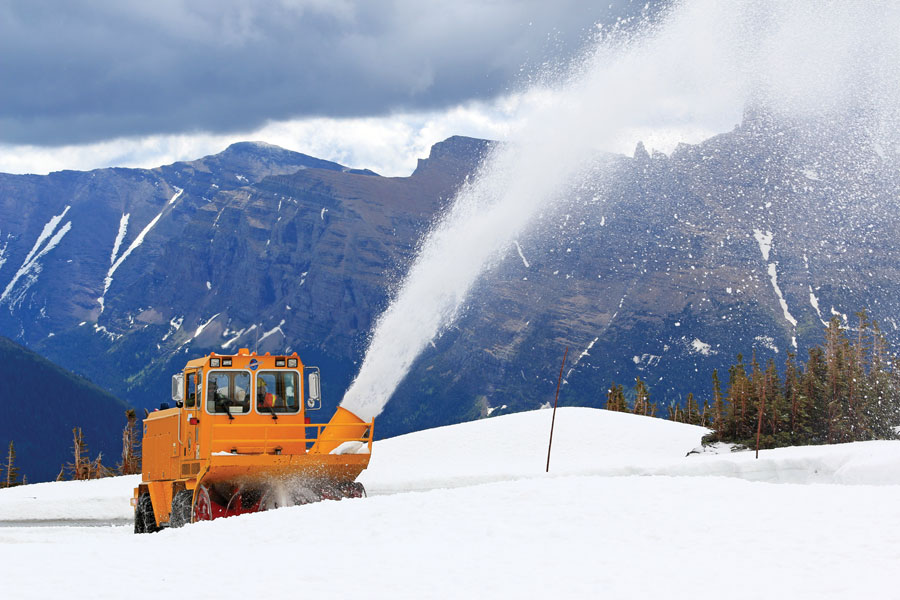A rumbling fleet of snowplows and excavators began the daunting task of clearing Glacier National Park’s roads last week, forging through a winter’s worth of snow and heralding springtime in Northwest Montana as the park prepares its iconic Going-to-the-Sun Road for the summer frenzy.
On the east side, crews are plowing the Two Medicine Road and the Chief Mountain Road, and next week will begin plowing the Many Glacier Road.
Also next week, west side crews will converge on West Glacier to begin scraping the Camas Road before turning their attention to the park’s iconic Going-to-the-Sun Road, where a season’s worth of heavy snowfall and spring avalanches will likely slow their progress.
The only section of the Sun Road currently open to automotive traffic is between Apgar and the Lake McDonald Lodge on the west side and to the foot of St. Mary Lake on the east, but visitors are welcome to travel “however far beyond that on skis,” according to Lauren Alley, Glacier Park’s public affairs specialist. Visitors can drive 11.5 miles from the west entrance to Lake McDonald Lodge, and one mile from the St. Mary entrance to the foot of St. Mary Lake.
The snowpack is well above average on both sides of the park, with the Flathead Basin on the west side reporting 137 percent of average and the St. Mary and Milk River Basins reporting 132 percent of average, according to data from the Natural Resources Conservation Service.
Snowpack levels measured on Flattop Mountain, elevation 6,300 feet, measured 52 inches of snow water equivalent — or the amount of water in the snowpack — which, as of March 30, was 120 percent above the median. The snow depth at the Flattop site is 134 inches, or more than 11 feet.
National Park Service rangers are preparing to conduct their second snow survey of the year along the Sun Road and will record snow depth and other measurements.
Last year, a similarly abundant snowpack meant Glacier’s plow crews had their work cut out for them, and the 50-mile Going-to-the-Sun Road didn’t fully open to Logan Pass until June 28.
The seasonal guessing game played by park employees and spring visitors as to when the full corridor will open is as much a part of the spring ritual as tracking the plow crews’ progress, and the National Park Service has established a website illustrating their whereabouts.
Each spring, separate road crews assemble on the park’s east-and-west boundaries, working in tandem on either side of Logan Pass until they reach the road’s high point at the Continental Divide and the final obstacle that awaits them — The Big Drift, a massive, windswept deposit of snow just east of Logan Pass that can loom upwards of 80-feet high and expose crews to steep avalanche paths.
Along the way, they’ll encounter a winter’s worth of hazards and hurdles.
The Sun Road corridor bristles with more than 40 major avalanche paths that can release destructive snow slides onto the road without a moment’s notice, and road-crew members know them all by name — names like The Grizzly, Swede Point, Weeping Wall, Alps of America, and Haystack Creek — as well as the safety zones and nearby refuges.
To assist the plows, avalanche technicians and snow scientists provide sophisticated forecast reports to determine when it is safe for the crews to work, and when it is best to pull back and wait. The experts ski above trigger zones to perform tests, and determine the snow stability and potential for avalanche.
Even with these safety measures in place, the monumental task of clearing the Sun Road each spring is daunting and perilous, particularly because 35 miles of it remain closed throughout the entire winter, meaning that each spring plow crews encounter an unknown labyrinth of avalanche runs, debris and heavy snowfall that has accumulated for months.
In order to relocate the road each spring, a dozer establishes a level roadbed for the equipment that follows, and each successive cut comes down closer to the roadbed. When the crews reach a point several feet above the roadbed, rubber-tired equipment moves in to finish the job, which rotary snow plows and end-loaders dispatch without damaging the road’s surface or its iconic guardrails.
Visit www.nps.gov/glac for the latest road conditions in Glacier National Park.
